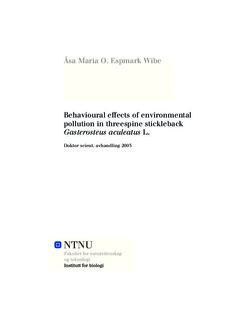| dc.contributor.author | Espmark, Åsa Maria | nb_NO |
| dc.date.accessioned | 2014-12-19T13:11:23Z | |
| dc.date.available | 2014-12-19T13:11:23Z | |
| dc.date.created | 2003-04-11 | nb_NO |
| dc.date.issued | 2003 | nb_NO |
| dc.identifier | 125196 | nb_NO |
| dc.identifier.isbn | 82-471-5170-7 | nb_NO |
| dc.identifier.uri | http://hdl.handle.net/11250/244619 | |
| dc.description.abstract | The aims of this study were to investigate the effects of known environmental contaminants on defined behavioural variables in fish, and to discuss properties of these behavioural traits that make them useful as potential indicators of pollution.
In studying the effects of pollution, the resulting biochemical and physiological alterations are more commonly measured. However, effects of pollution can manifest itself at all levels of biological organisation, including behaviour. In this respect, behaviour can be considered a valid biomarker of pollution in that it is expected to be both susceptible to pollution and of high ecological significance, as it influences the fitness of the affected individuals.
This thesis is based on four individual studies, in which the threespine stickleback Gasterosteus aculeatus was used as a model species. Results from these studies show that antipredator behaviour, feeding behaviour, shoaling behaviour, bottom-dwelling behaviour and reproductive behaviour are all sensitive to exposure to sublethal concentrations of defined environmentally relevant chemicals.
The results showed that antipredator behaviour and fright response in threespine stickleback were impaired following exposure to sublethal concentrations of bis(tributyltin)oxide (TBTO). However, for some of the tested antipredator variables the effects were reversed after the ending of exposure. Further, it was shown that feeding motivation in fish exposed to butyl benzyl phthalate (BBP) and/or 2,2-bis(p-chlorophenyl)-1,1-dichloroethylene (DDE) was increased in that exposed fish initiated feeding more often than the controls. Exposure to BBP also caused sticklebacks to aggregate into tight shoals and to spend more time at the bottom of the aquarium compared to the control fish.
The reported significant differences between the controls and BBPexposed fish with respect to feeding and shoaling behaviour were shown even though the levels of BBP were below the analytical detection limit. Different suggested explanations, for example, too high detection limit, or degradation to its BBP metabolites are given to this result.
17β-Oestradiol (E2) exposed male sticklebacks started nest building later than non-exposed males, but there were no differences between exposed and control males with respect to the number of males that built nests. Further, the exposed males spent less time displaying paternal care compared to the control males, although there were no differences between the two groups in the number of performed courtship displays. Because of the significant effect upon some but not all reproductive behavioural traits, it was suggested that the different variables might vary in sensitivity, implying that a variety of variables should be studied in order to obtain a more reliable evaluation of the effects of pollution.
Chemicals can cause deleterious effects at one or more levels of biological organisation, from biochemical, physiological, individual, population and through to the ecosystem levels. In contrast to the established hypothesis that a pollutant affects the different biological levels in an escalating timedependent pattern, starting at the biochemical level, it is here suggested that biomarkers at the biochemical, physiological and behavioural levels often will respond early and simultaneously in the same individual.
Whereas some biochemical responses are specifically related to one class of exposure agents and thus may act as specific indicators of pollution, most behavioural traits may be altered in response to a variety of chemicals. One exception may be alterations in reproductive behaviour caused by endocrine disrupting chemicals, due to effects of the chemicals on hormones that result in immediate reproductive behavioural effects. In spite of the specific action of some biochemical biomarkers, they are often considered to be of little ecological relevance since many of them are not related to individual fitness.
In this thesis, it is argued that behavioural variables can be employed as useful and reliable biomarkers of environmental contamination. It is also important to focus on behaviour to map and quantify the resposes. However, to reliably evaluate the effects of pollution, behavioural variables should be used in association with biochemical and physiological traits. Moreover, optimal combination of results from laboratory and field experiments would enhance the ecological relevance of the study. | nb_NO |
| dc.language | eng | nb_NO |
| dc.publisher | Fakultet for naturvitenskap og teknologi | nb_NO |
| dc.relation.haspart | Espmark, Åsa; Nordtug, Trond; Jenssen, Bjørn Munro. Effects of bis(tributyltin)oxide on antipredator behavior in threespine stickleback Gasterosteus aculeatus L.. Chemosphere . 44(3): 475-481, 2001. | nb_NO |
| dc.relation.haspart | Espmark, Åsa; Fjeld, Eirik; Rosenqvist, Gunilla; Jenssen, Bjørn Munro. Postexposure effects of DDE and butylbenzylphthalate on feeding behavior in threespine stickleback. Ecotoxicology and Environmental Safety. 57(2): 213-219, 2004. | nb_NO |
| dc.relation.haspart | Espmark, Åsa; Billing, Anna; Rosenqvist, Gunilla; Jenssen, Bjørn Munro. Butyl Benzyl Phthalate Affects Shoaling Behavior and Bottom-Dwelling Behavior in Threespine Stickleback. Environmental Research. 89(2): 180-187, 2002. | nb_NO |
| dc.relation.haspart | Espmark, Åsa; Rosenqvist, Gunilla; Jenssen, Bjørn Munro. Disruption of Male Reproductive Behavior in Threespine Stickleback Gasterosteus aculeatus Exposed to 17β-Estradiol. Environmental Research. 90(2): 136-141, 2002. | nb_NO |
| dc.subject | Biology | en_GB |
| dc.subject | NATURAL SCIENCES: Biology | en_GB |
| dc.title | Behavioural effects on environmental pollution in threespine stickleback Gasterosteus aculeatus L | nb_NO |
| dc.type | Doctoral thesis | nb_NO |
| dc.contributor.department | Norges teknisk-naturvitenskapelige universitet, Fakultet for naturvitenskap og teknologi, Institutt for biologi | nb_NO |
| dc.description.degree | dr.scient. | nb_NO |
| dc.description.degree | dr.scient. | en_GB |
